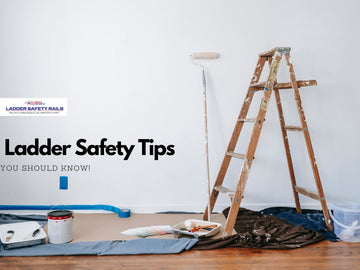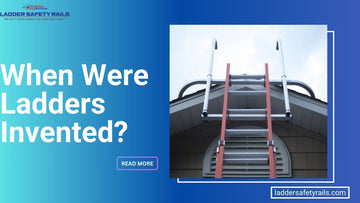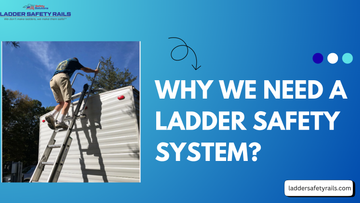
Ladder safety is of the utmost significance to avoid accidents and maintain a safe working environment. For both professionals and homeowners, it's critical to comprehend and adhere to ladder safety rules. This blog post discusses several typical ladder safety risks and how safety rails can help prevent them. It will increase the stability of the ladder and the user's confidence.
What is the most common ladder safety hazard associated with ladder use?
Ladder safety hazards are potential risks and dangers that can lead to accidents and injuries while using ladders. These hazards can arise from various factors, and it is crucial to be aware of them to prevent accidents. Some common ladder safety hazards include:
- Incorrect ladder selection: Choosing the wrong type or size of ladder for the task can lead to instability and accidents.
- Overreaching: Stretching too far while on the ladder can cause it to become unbalanced and may result in a fall.
- Poor ladder placement: Placing the ladder on uneven or unstable surfaces can cause it to tip over or slip.
- Missing or damaged parts: Broken or missing rungs, steps, or feet can compromise ladder stability and lead to accidents.
- Inadequate ladder inspection: Failing to regularly inspect the ladder for defects or damage can increase the risk of accidents.
- Overloading: Exceeding the ladder's weight capacity can cause it to collapse under the user's weight.
- Incorrect angle: Setting up the ladder at the wrong angle can decrease stability and increase the likelihood of falls.
- Using a damaged ladder: Continuing to use a ladder with dents, bends, or other damage can be hazardous.
- Climbing the top step: Standing on the top step or platform of the ladder can lead to instability and falls.
- Not maintaining three points of contact: Failing to have both feet and one hand or both hands and one foot on the ladder while climbing can lead to loss of balance.
- Carrying heavy or bulky objects: Trying to carry items while climbing the ladder can hinder balance and increase the risk of falling.
- Rushing or working too quickly: Haste and not being cautious can lead to accidents while using ladders.
To ensure ladder safety, it is essential to select the right ladder for the task, inspect it regularly for damage, set it up on a stable surface, use the correct angle, and follow safe climbing practices, such as maintaining three points of contact and avoiding overreaching. Additionally, using appropriate personal protective equipment (PPE) like non-slip footwear and maintaining a clear work area can also help minimize ladder-related accidents.

What are the top ladder safety tip for regular users?
Here are some essential ladder safety tips to remember:
-
Maintain three points of contact: Always have a secure grip on the ladder with your hands or feet to ensure stability while climbing.
-
Ensure proper ladder placement and stability: Set the ladder on a stable surface, use ladder levelers or soft-touch bumpers if necessary, and secure the ladder to prevent wobbling or shifting.
-
Avoid overreaching and leaning on the ladder: Maintain your body within the ladder's side rails and avoid leaning excessively, as it can lead to imbalance and falls.
-
Be mindful of weight capacity: Check the ladder's weight capacity and refrain from exceeding it to maintain stability and prevent structural damage.
-
Consider weather conditions and surroundings: Avoid using ladders outdoors during adverse weather conditions like strong winds or rain and be cautious of overhead power lines or other obstacles.
-
Seek assistance when needed: If a task requires more than one person or exceeds your comfort level, seek help or consider using alternative equipment.
- General safety guidelines: Wear proper footwear, tidy your workspace, and stay focused when using a ladder.
- Proper ladder selection: Select the right ladder for the task at hand, considering height requirements, weight capacity, and material compatibility.
- Setting up the ladder correctly: Ensure it is on a stable and level surface, extend it to the appropriate height, and secure it with proper locking mechanisms.
- Climbing and working on the ladder safely: Maintain three points of contact (two feet and one hand or two hands and one foot) while climbing, and never overreach beyond a comfortable distance.
- Descending from the ladder safely: Face the ladder and use controlled movements when descending to avoid slips and falls.
- Importance of regular ladder maintenance and inspections: Regularly inspect the ladder for any signs of damage, such as cracked rungs or loose fittings, and promptly address any issues.

What are best practices for Extension ladder safety?
Working with extension ladders presents specific safety considerations. Follow these best practices:
- Setting up an extension ladder securely: Extend the ladder to the appropriate height, ensuring the rung locks engage correctly and the base is secured.
- Using extension Ladder stabilizers or Safety Rails: Use Ladder Safety Rails, such as LadderSafetyRails™, to enhance stability and provide handrail support while ascending or descending.
- Maintaining stability while working on an extension ladder: Avoid sudden movements or shifting of weight, and never stand on the top rungs or overreach.
- Avoid common extension ladder accidents: Watch for overhead obstacles, maintain a safe distance from electrical sources, and use caution when transitioning onto a roof or other surface.
- Safety precautions when ascending and descending an extension ladder: Face the ladder, maintain a firm grip on the rungs, and descend slowly and carefully.
What equipment can we use to reduce fall risk?
The patented Ladder Safety Rails hand rail system, for example, offers a revolutionary design for Ladder Safety Rails that vastly increases user comfort and safety.
These adjustable ladder stabilizers were created and built by experts in the construction and aerospace sectors to fit all standard extension ladders and offer additional safety advantages to commercial contractors, roofers, electricians, painters, carpenters, house inspectors, and homeowners.
Ladder Safety Rails are dependable and adaptable because of their sturdy design, simple installation process, and small footprint.

Final remarks
Prioritizing ladder safety is essential to preventing accidents and injuries. By following ladder safety rules, implementing top safety tips, and utilizing solutions like Ladder Safety Rails from laddersafetyrails.com, individuals can significantly enhance ladder stability and reduce the risk of falls.
Remember, a few extra precautions and the proper safety equipment can make a difference in ensuring a safe and productive work environment. Stay safe, confident, and protected with Ladder Safety Rails.





